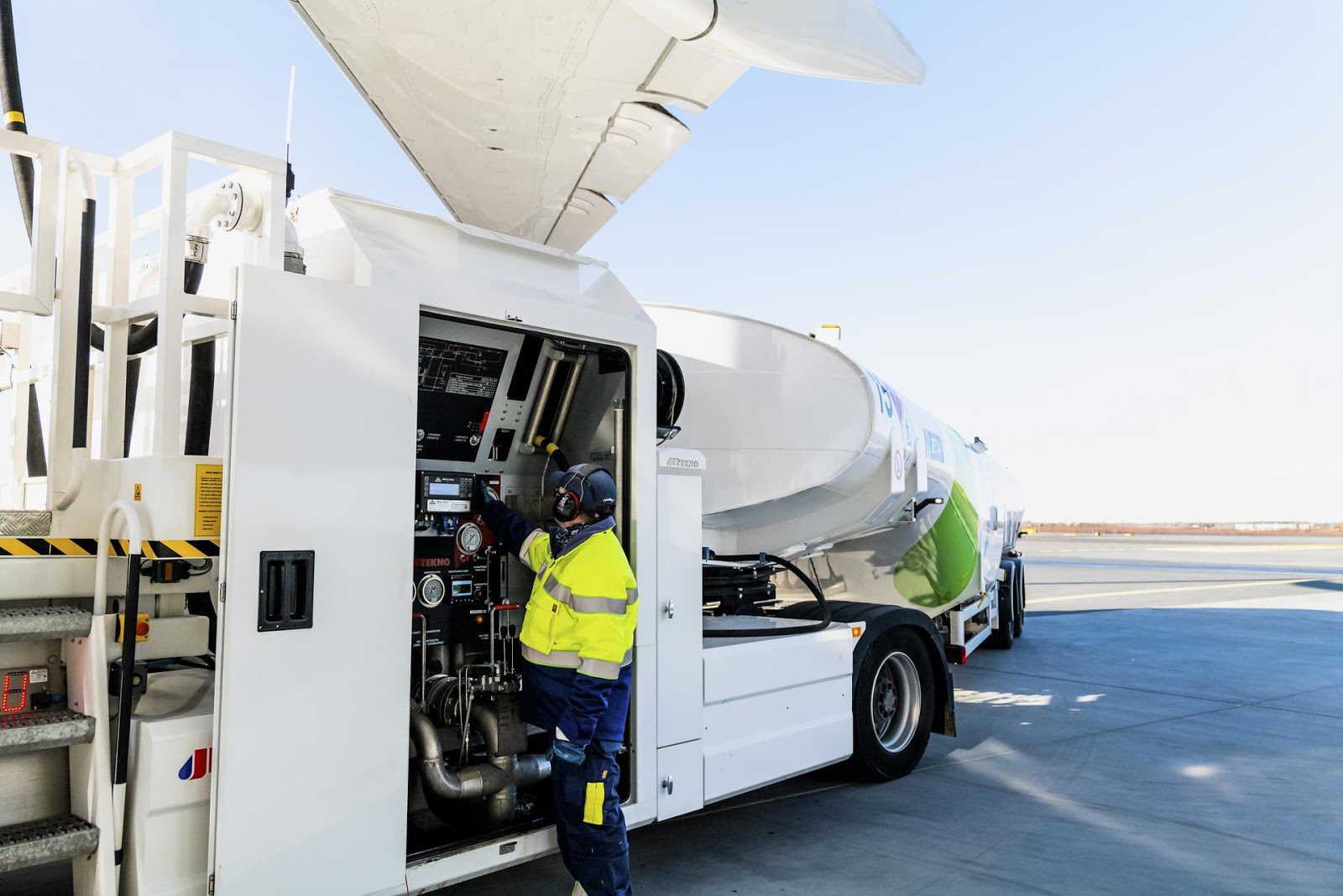Skift Take
In terms of saving the planet, the next best thing to not flying long-haul could be flying on a plane that uses sustainable fuel. Many companies are buying into this now, but it's still early days.
A new report has questioned just how green flying can become, despite the aviation industry appearing to be on track to hit some agreed emission reduction targets over the next few decades.
The study, published by several universities in Nature Communications on Tuesday, also warned that the pandemic’s travel restrictions will only have a temporary effect on aviation’s climate impact, because international flights are seen as critical to kick-starting the global recovery.
However, its authors appear to be supporting the use of sustainable aviation fuels — something many travel agencies, their corporate customers and airlines are backing. Are they the answer?
More Than Carbon Dioxide
Aircraft contribute to climate change by creating carbon dioxide, but there are non-carbon dioxide effects too, the study, “Evaluating the climate impact of aviation emission scenarios towards the Paris agreement including Covid-19 effects,” points out.
These include nitrogen oxides, ozone and contrail cirrus clouds, which it said contribute to global warming. And they’re not included in the International Civil Aviation Organisation’s goal of climate neutral growth, and only partly addressed in the European Commission’s Flightpath 2050, it added.
Join Us at the Skift Destination and Sustainability Summit on July 21
Overall, Europe’s aviation sector wants to eliminate its net carbon dioxide emissions by 2050.
“Technological improvements to engines and airframes and operations won’t be enough to sufficiently reduce the impact of aviation on climate change,” said Dr Simon Blakey, senior lecturer in mechanical engineering, at the UK’s University of Birmingham, which contributed to the report. “We must explore all mitigation options in parallel — including the increased use of sustainable fuels and market based measures in order to limit aviation’s impact on the environment.”
Clearly, if a business traveler wants to take action, the most efficient way to reduce their carbon footprint is to not fly but Zoom instead.
If it’s an essential trip, they’d need to consider alternative modes of transport, such as rail. And there is willingness to be greener; some 97 percent of corporate travelers would increase journey time if it significantly reduced environmental impact, while 80 percent are more inclined to work for an organization with a sustainability policy, according to SAP Concur research.
After rail, taking a plane filled with sustainable fuel could be the next best option — at least until electric aircraft go mainstream. Currently, aircraft don’t need to be modified to use sustainable fuel, as they blend it (up to 50 percent) with conventional fossil jet fuel. The overall footprint benefit is realized because of the way the fuel’s made. For example Neste, one of the biggest producers of sustainable fuel, manufactures it from sustainably sourced renewable waste and residue raw materials.
The new report argues that if airlines do fly aircraft using this type of fuel, the non-carbon dioxide effects can be less harmful.
“Accounting for sustainable fuels must include the impact of non-carbon dioxide emissions in use as well as the carbon dioxide emissions in fuel production. If we base all our calculations on carbon dioxide alone, we miss the large improvements in non-carbon dioxide emissions that these fuels can offer, particularly in reducing particulate matter emissions which contribute to an increased warming effect at cruise conditions,” Blakey said.
Direct From the Source
The study’s publication comes days after a new partnership between Neste and Boston Consulting Group was announced. The consultancy will purchase Neste’s sustainable fuel, which will be delivered to SAS and Finnair, and cover the volume of all the flights with these airlines taken by BCG’s employees in the Nordics.
BCG will be the first corporate client of Neste, which represents a shift from most of the other corporate alliances so far. “In my view, they’re the first corporation in the world to make a direct purchase of sustainable fuel from the producer,” said John Harvey, managing partner at consultancy Harvey & Heywood. “Other people have done it through schemes that have been assembled by the airlines, where the airline goes out to buy some fuel and tries to get corporates to help fund it.”
And there have been plenty of these types of schemes announced over the past 12 months. In May, Shell Aviation and American Express Global Business Travel began a collaboration to make sustainable fuel available. In April, United Airlines launched its United Eco-Skies Alliance Program, with some of its global corporate clients paying towards more sustainable fuel. They include Autodesk, Deloitte, DHL Global Forwarding, Nike, Palantir and Siemens, as well as Boston Consulting Group. Collectively they’ll contribute towards the purchase of 3.4 million gallons of sustainable fuel.
In the same month, Lufthansa made sustainable fuel available to AXA Deutschland, while in October 2020 Alaska Airlines and Microsoft signed a partnership to reduce carbon emissions with flights powered by sustainable fuel on key routes.
These alliances are a step in the right direction, but the amount of sustainable fuel available appears to be a fraction of what carriers typically burn through. Heywood estimates in a normal year, the world’s airlines use 300 million tons of fuel, but the amount of sustainable fuel available is 200,000 to 300,000 tons.
One reason there’s not a lot of this fuel around is because it costs a lot to make it.
“We need to demonstrate to investors and the industry that we’re ready,” said Sarah Wilkin, founder and CEO Fly Green Alliance, speaking at the SAP Concur Travel Industry Summit last week. The concept behind many of the alliances is to drum up interest, commit big dollars and eventually bring the average fuel price down. Wilkin also believes the new fuel has the best chance of reducing aviation’s harmful effects on the environment.
“Last week we were at an International Air Transport Association conference, which was talking about 2050 goals. The industry was very aligned on that it was a new phase,” she said, adding the areas of focus were around improving air traffic management, improving efficiency, upgrading fleets, offsetting and sustainable fuel.
“The majority of scenarios include sustainable aviation fuel, that’s the majority of the emissions reduction. In July we’re expecting mandates in Europe. Norway has one mandate which is 0.5 percent sustainable fuel into their global supply. It’s likely to spread to Europe. It’s down to governments,” she added. “For travel buyers and agencies, they have a key role in developing the fuel market.”
However, one travel buyer, who preferred to withhold their name, told Skift that many companies simply see sustainable fuel as a box ticking exercise.
“It’s another tool to please our conscience that we’re doing something meaningful, and to tick the box. You could also argue that if you do this institutionally, if a travel program will pay for each and every mile, it’s still a fraction of the total,” he said.
The main driver was the tax incentives, and the politics behind that, he added. “Until governments are really thinking this is the future, it’s going to be limited. Once the oil companies are onboard, it will be a different ball game when it comes to influencing governments.”
Meanwhile, there’s a risk that if a sustainable fuel option does become embedded in a company’s travel policy, it could remove the need for the employee to question whether they need to travel.
At a time when carbon calculations are gaining momentum, and more airlines are experimenting with ways to get their corporate customers onboard, the next couple of years could be a tipping point for producers like Neste, as well as SkyNRG. The travel buyer also predicted that in the future more airlines will include the fuel as an option in their so-called New Distribution Capability fares, which would drive more funding.
The question is, would this, and the new corporate alliances, be enough to satisfy the authors of this new report?
Register Now for the Skift Destination and Sustainability Summit on July 21
The Daily Newsletter
Our daily coverage of the global travel industry. Written by editors and analysts from across Skift’s brands.
Have a confidential tip for Skift? Get in touch
Tags: air france-klm, alaska airlines, american express global business travel, climate change, coronavirus, cwt, delta air lines, finnair, lufthansa, microsoft, sas, sustainability, united airlines
Photo credit: Neste is one of the biggest sustainable aviation fuel producers. Neste

